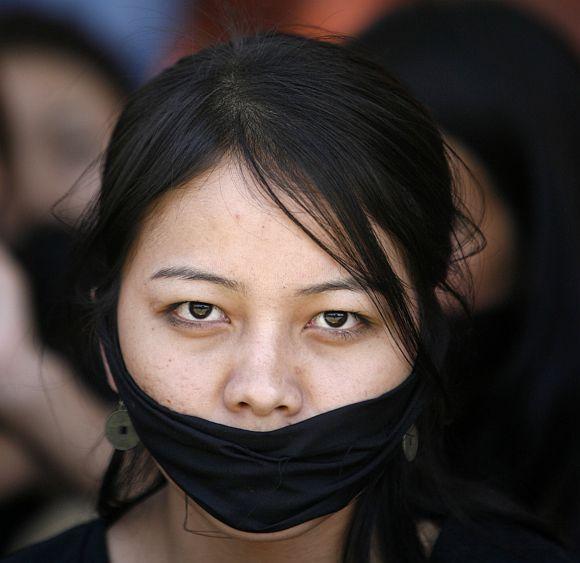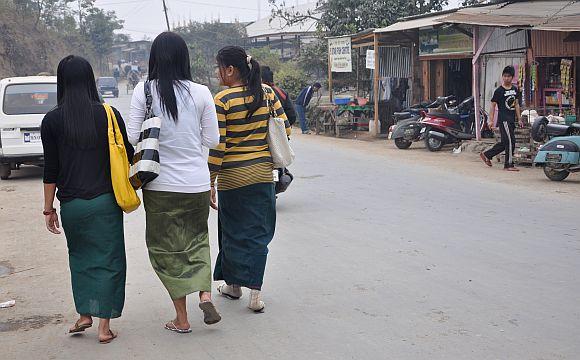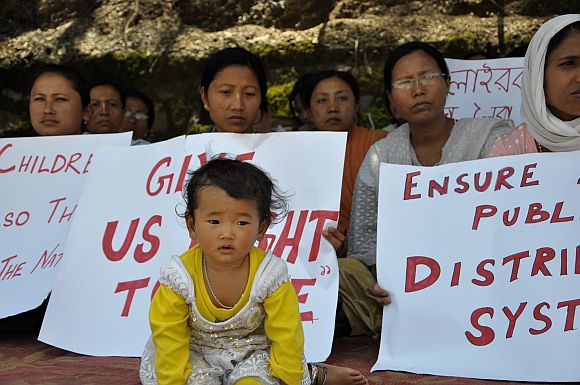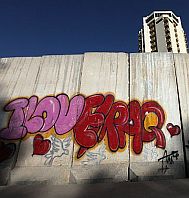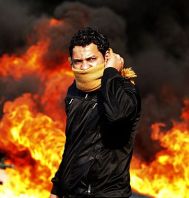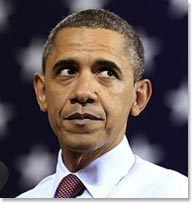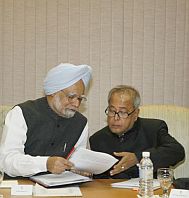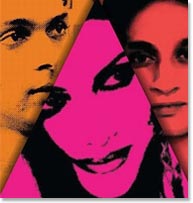 | « Back to article | Print this article |
Do women really take the lead in Manipur?
The international and national media spotlight on the women of Manipur as leaders in the social and political spheres is plagued by a rose-tinted hue, says Chitra Ahanthem, an activist, columnist and mother who lives in Imphal.
I live in Manipur, a small state in the little known north-eastern part of the country. It is often a blip on the national consciousness and in mainstream media. The state has produced world champions in sporting disciplines but any media mention of them is tucked away on the 20th page.
The only instance of Manipur being front-page news was when 12 women stripped before the gates of the historic Kangla Fort, which was then occupied by the Assam Riffles.
When the images of 12 naked women in their 50s and 60s made it to the cover of a national weekly, it led to a sudden media focus on the state and its women.
Over the years, not much has changed. Manipur still continues to be in the news only when things get drastic. As in when the state is caught in the grip of economic blockades and the supply of essential items gets choked. As in when this happens for 100 days and more.
The media spotlight on the women of Manipur as leaders in the social and political spheres also continues in a rose-tinted hue. The latest economic blockade brought home even the international media.
And keeping to the script, they wrote about how the blockades on the highways were affecting life. And then, they wrote about the women who were leading the blockades on the highways.
Please click NEXT to read further..
'It is the woman who gets used, abused and dictated upon'
To an outsider, women leading street protests and agitations looks like women's empowerment. The existence of the Ima Market (Mother's Market) run only by women adds the extra bit. Ditto with the historical Nupi Lal -- Women's War, literally, the women's uprising against the British in 1939.
The visual imagery of women holding flame torches and keeping guard of localities or haranguing with security personnel often compel a ready association with woman power.
The truth is more complex.
There needs to be an objective look at whether the visibility of women in sit in protests, rallies and demonstrations against government action -- or inaction -- is any yardstick for the role of women.
When representatives of the groups calling for agitations go in for negotiations over their demands with the government, very often it is a men-only group.
I cannot recall a sizeable number of rallies, sit in protests or any other forms of agitation that calls for the larger ambit of issues related to women, leave alone address those around the right violations infringed upon by non-state forces.
The naked protest in 2004 was after the brutal rape (alleged) and murder of a woman, Thangjam Manorama, alleged to be a member of a particular armed underground group by the Assam Riffles. Alleged, because the condition of Manorama's body was such that there could not be any medical examination over whether she had been raped.
But in about the same year, a young woman called Meneka was killed by an underground group on the charge that she was an army informer.
There were no agitations, no protests. As a woman, both incidents pain me deeply.
While the army goes scot free with the impunity that the Armed Forces Special Powers Act renders to it and the underground groups use the leverage of social guardianship from a high 'moral' ground, it is the woman who gets used, abused and dictated upon.
The row over the traditional 'phanek'
Sometime in 2000, one particular underground group called for a ban on women/girls wearing what they called 'Indian dresses'. This meant that women in the state could no longer wear saris or salwar suits. They could only wear the traditional phanek, the lower body wrap.
I remember being invited for a state-level discussion of women leaders, including academics, who would deliberate on the diktat.
I never went for that meeting, since such a discussion would mean that we the women were accepting the diktat imposed on us and, in doing so, acknowledging their hold over us.
It was very disappointing that the most celebrated women of the state then -- including intellectuals, academics, doctors, social leaders -- all ended up appealing to the said underground group to consider their ban!
The thread of discussion was based on the bit about the ban of saris since working women in the state do wear half saris with phaneks!
To cut a long story short, the group ended up revoking the ban but amended it to make it mandatory for girls wearing the phanek to school from Class 11 onwards.
Since I write a weekly column in a popular English daily published in Imphal, I wrote a piece against the ban and went about wearing salwar suits.
'None will address larger issues of health, sanitation or civic amenities'
That ended in me being approached by young students to discuss on what could be done about the ban and what line of action would be followed by the girl students. I addressed a huge meeting of students -- boys and girls -- from various schools who had all got together. We agreed to form a core group who would organise public meetings on the unfairness of the ban -- since boys did not have to wear traditional getup.
A few days later, I learnt that all the core group members had been 'warned' not to continue with their discussions. And then, it was my turn. Unfortunately, I was out of Imphal then and it was only my colleagues who got scared for my safety.
I could cite many other instances from my own experience that mirror the reality of women in Manipur. I could begin by saying that even the children that a woman bears are not hers in case she remarries. She is then meant to leave them behind. This is particularly true for the Meiteis, the majority Hindu community in the state.
I would definitely say that the discourse around women coming from the women in various civil society groups are fragmented on ethnic grounds: Each group will look at human rights violations committed by state forces only against those belonging to that particular group.
None will address larger issues of health, sanitation or civic amenities.
I would point out that we have had less than 10 women elected leaders at both the assembly and parliament level out of which a majority entered the political sphere as extensions of the political existence -- or non existence -- of their husbands.
'In reality, a movement with women pushed to the front'
In the cultural and social sphere, women's participation is defined by patriarchal norms. Women lead marriage processions -- but only women who have sons as their first-born.
In more orthodox families, widows are not even allowed to be a part of the ritual when the bridegroom reaches the marriage venue.
I have often wondered what happens to the women who lead agitations on the streets. Do they take decisions in their family? Do they own property? I don't think so.
There can be no deeper irony than the reactions of 'women's leaders' when they are confronted with issues of, say, domestic violence among their own sisterhood.
The immediate reaction is that the victim of violence at the hands of a husband or a family member has to be accepted by the victim as something that happens in the heat of differences.
There are no mechanisms for referring both victim and perpetrator for counseling but rather, the issue is sidelined to the margins of eerie silence.
I am not very comfortable with the stoic silence on women who have succumbed to bullets and other forms of violence perpetuated by non-state forces.
An academic I know, a woman, once told me that the "so called women's movement is in reality a movement with women pushed to the front".
I agree with the statement totally for women's movements across the world are democratised with no distinctions on ethnicity, race or qualifications. Rather, there is a commonality of womanhood and shared ideals of sticking together for the cause of women.
The women of Manipur are yet to reach there.
